Pomegranates & margaritas
As I walked the dog yesterday, I noticed that two pomegranate trees a block away are starting to bloom. The family that lives there has many fruit trees, but the bright red pomegranate blossoms are visible from quite a distance—as are the fruit in the fall.
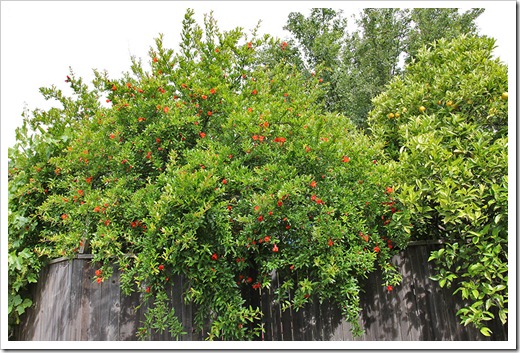 |
The pomegranate (Punica granatum) is native to the Iranian Plateau and the Himalayas of northern Pakistan and India but has been cultivated since ancient times in the Mediterranean regions of Asia, Africa and Europe. It followed the Spaniards to the New World and has become established in Mexico, Arizona, and California. In fact, the Sacramento Valley’s Mediterranean climate offers perfect growing conditions for pomegranates, as evidenced by the many pomegranate trees all over Davis.
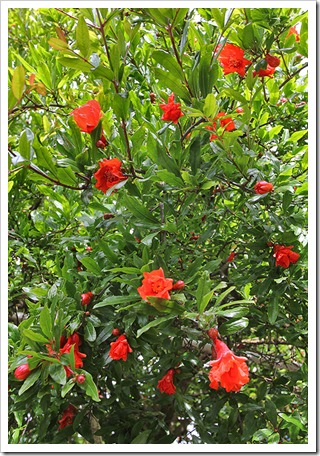 |
Our neighbors have regular Punica granatum trees (about 12 ft. tall). These are the trees grown for fruit production. There is also a Japanese dwarf variety called Punica granatum ‘Nana’ which is grown purely for ornamental purposes. It does very well in containers and is reputed to be hardier than its big brother (5°-10°F).
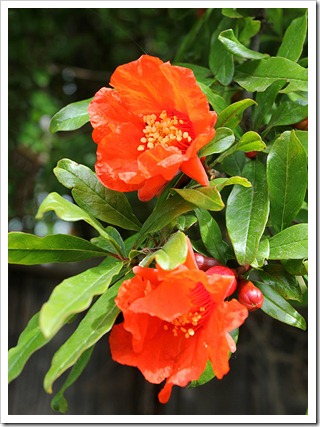 |
Punica granatum prefers cool winters and hot summers. Once established, it requires little irrigation to survive but fruit production is greatly enhanced by regular deep watering.
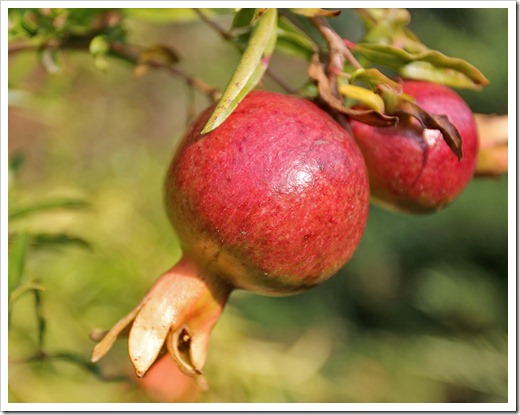 |
The fruit begins to ripen 6-7 months after blooming, typically October-November in our zone. Like apples, pomegranates have a long storage life. In fact, they become juicier and more flavorful with some storage. We have friends with a pomegranate tree and they keep us supplied with fruit. Stored in the kitchen, the fruit easily keeps 4-6 weeks. I read that it can be kept for up to 7 months if stored between 32° and 41°F at 80-85% relative humidity.
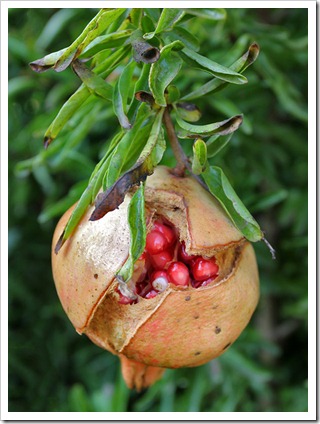 |
Many people consider pomegranates to be a royal pain when it comes to opening the fruit and getting at the garnet-colored seed casings (arils) that form the edible juicy parts. Since the juice leaves stains that are hard to remove, this is the method I use: Score the fruit with a knife, submerge it in a bowl of water, and break it in half. Then, while submerged, separate the red arils from the peel and the white pulp membranes. The arils will sink while the pulp floats to the top. The whole process takes me a good 15-20 minutes per fruit but I love pomegranate so much that it’s worth it.
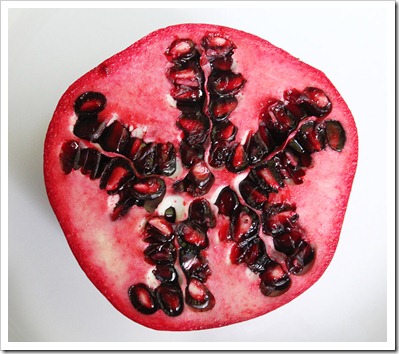 |
The seeds (or technically seed casings) are great eaten raw or in a mixed salad. Think baby greens with chunks of apple or jicama, dressed in a tahini vinaigrette and topped with pomegranate seeds and goat cheese crumbles.
In Mexico, chiles en nogada (poblano chiles stuffed with a pork picadillo, served with a white walnut sauce, and sprinkled with pomegranate seeds) is a popular dish on Independence Day (September 16th) because the green, white and red of the dish mirrors the colors of the Mexican flag.
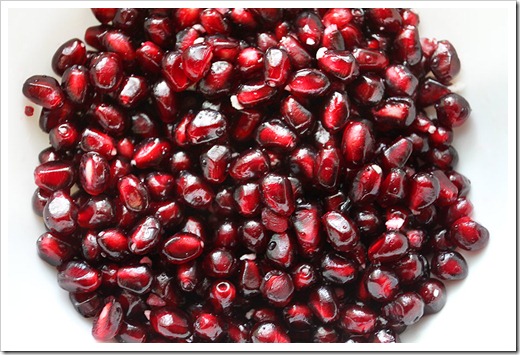 |
In recent years, pomegranate juice has become widely available in the U.S., mainly because of the marketing efforts of POM Wonderful. Their distinctive “double-bulb” bottle has become one of the most recognizable packaging designs of the last decade. POM’s web site has a wealth of historical information that allows you to trace the “path of the pomegranate” around the world.
I love drinking pomegranate juice and cooking with pomegranate syrup, a staple in Middle Eastern cuisines. However, my favorite use for pomegranate juice is in margaritas, our cocktail of choice in the summer. Commercial margarita mixes are much too sweet and artificial tasting in my opinion. And while I don’t like to brag, I will say that I am a margarita expert, having sacrificed millions of brain cells in the pursuit of margarita excellence.
Making margaritas from scratch—or close to it—is as easy as can be. Here’s a simple but incredibly tasty recipe for pomegranate margarita. It makes a pitcher, enough for 4 tall glasses (I don’t like the traditional shallow margarita glasses and much prefer tall drinking glasses; in fact, pint-sized beer glasses work great).
5 oz fresh-squeezed lime juice
5 oz pomegranate juice
3 oz frozen limeade concentrate (in the frozen juice section of the supermarket)
2 oz triple sec (or other orange liqueur)
6 oz decent-quality tequila (it doesn’t have to be reposado or añejo, but stay away from the cheapest tequila; something like José Cuervo Gold is just fine)
Mix in electric blender for a few seconds; then fill pitcher with ice cubes and blend until slushy.
When I started to write this post I had no idea that I was going to end it with a margarita recipe. Come to think of it, that’s actually a pretty awesome closing note, especially on this Memorial Day weekend.
I’ll be sure to enjoy a margarita or two myself!

Your salad combination sounds great. I just bought pomegranate popsicles yesterday because the weather turned to high 80's overnight and will last for the weekend. One of my cousins who lives in CA brings me a pomegranate from her tree every Thanksgiving when she comes east.
ReplyDeleteEnjoy your margaritas.... anne
I have everything on hand for that margarita recipe already... except for every ingredient but ice. I may need to make a trip to the store...
ReplyDeleteBut I'm just not a fan of eating pomegranate. How do you get past the sensation that you're eating bits of wood (the seeds)? It just ruins it for me.
I would definitely grow a fruit-producing pom tree if I could though. :-)
Anne, a home-grown pomegranate for Thanksgiving, what a classy gift. I think pomegranate is a very festive fruit.
ReplyDeleteAlan, I know what you mean about the seeds. They don't bother me but you can't just pretend they're not there. Juice is the way to go then. Let me know how the margaritas turn out. I like them sour but if they're too sour for you, add more limeade concentrate.
Happy Memorial Day to all of you!